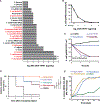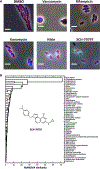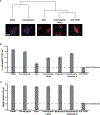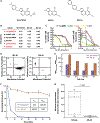A Dual-Mechanism Antibiotic Kills Gram-Negative Bacteria and Avoids Drug Resistance
- PMID: 32497502
- PMCID: PMC7780349
- DOI: 10.1016/j.cell.2020.05.005
A Dual-Mechanism Antibiotic Kills Gram-Negative Bacteria and Avoids Drug Resistance
Abstract
The rise of antibiotic resistance and declining discovery of new antibiotics has created a global health crisis. Of particular concern, no new antibiotic classes have been approved for treating Gram-negative pathogens in decades. Here, we characterize a compound, SCH-79797, that kills both Gram-negative and Gram-positive bacteria through a unique dual-targeting mechanism of action (MoA) with undetectably low resistance frequencies. To characterize its MoA, we combined quantitative imaging, proteomic, genetic, metabolomic, and cell-based assays. This pipeline demonstrates that SCH-79797 has two independent cellular targets, folate metabolism and bacterial membrane integrity, and outperforms combination treatments in killing methicillin-resistant Staphylococcus aureus (MRSA) persisters. Building on the molecular core of SCH-79797, we developed a derivative, Irresistin-16, with increased potency and showed its efficacy against Neisseria gonorrhoeae in a mouse vaginal infection model. This promising antibiotic lead suggests that combining multiple MoAs onto a single chemical scaffold may be an underappreciated approach to targeting challenging bacterial pathogens.
Keywords: Acinetobacter baumannii; Gram-negative pathogens; Neisseria gonorrhoeae; antibiotics; broad spectrum; dual-target drugs; folate metabolism; membrane disrupting.
Copyright © 2020 Elsevier Inc. All rights reserved.
Conflict of interest statement
Declaration of Interests A patent application describing the use of SCH-79797 as an antibiotic, as well as the pharmaceutical composition and use as antibiotic of derivatives is currently pending.
Figures







Comment in
-
Two birds with one stone.Nat Rev Microbiol. 2020 Aug;18(8):412-413. doi: 10.1038/s41579-020-0401-4. Nat Rev Microbiol. 2020. PMID: 32555431 No abstract available.
-
Dual-mechanism antibiotics.Nat Microbiol. 2020 Aug;5(8):984-985. doi: 10.1038/s41564-020-0767-0. Nat Microbiol. 2020. PMID: 32710093 No abstract available.
References
-
- Ahn HS, Foster C, Boykow G, Stamford A, Manna M, and Graziano M (2000). Inhibition of cellular action of thrombin by N3-cyclopropyl-7-[[4-(1-methylethyl)phenyl]methyl]-7H-pyrrolo[3, 2-f]quinazoline-1,3-diamine (SCH 79797), a nonpeptide thrombin receptor antagonist. Biochem. Pharmacol 60, 1425–1434. - PubMed
-
- Amyes SG, and Smith JT (1975). Thymineless mutants and their resistance to trimethoprim. J. Antimicrob. Chemother 1, 85–89. - PubMed
-
- Becher I, Werner T, Doce C, Zaal EA, Tögel I, Khan CA, Rueger A, Muelbaier M, Salzer E, Berkers CR, et al. (2016). Thermal profiling reveals phenylalanine hydroxylase as an off-target of panobinostat. Nat. Chem. Biol 12, 908–910. - PubMed
-
- Boucher HW, Talbot GH, Bradley JS, Edwards JE, Gilbert D, Rice LB, Scheld M, Spellberg B, and Bartlett J (2009). Bad bugs, no drugs: no ESKAPE! An update from the Infectious Diseases Society of America. Clin. Infect. Dis 48, 1–12. - PubMed
Publication types
MeSH terms
Substances
Grants and funding
LinkOut - more resources
Full Text Sources
Other Literature Sources
Miscellaneous

